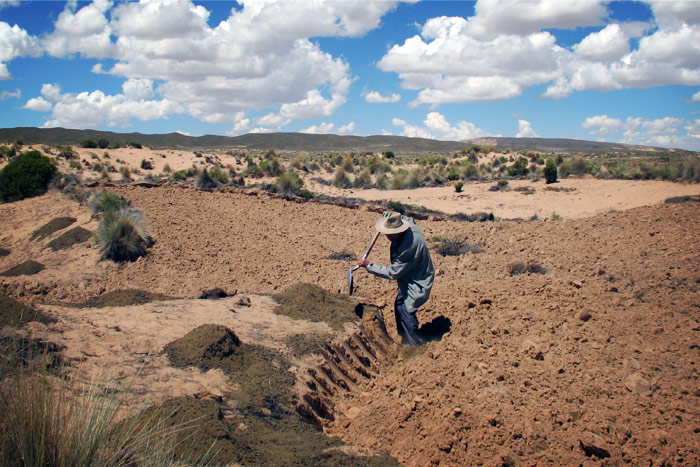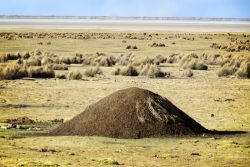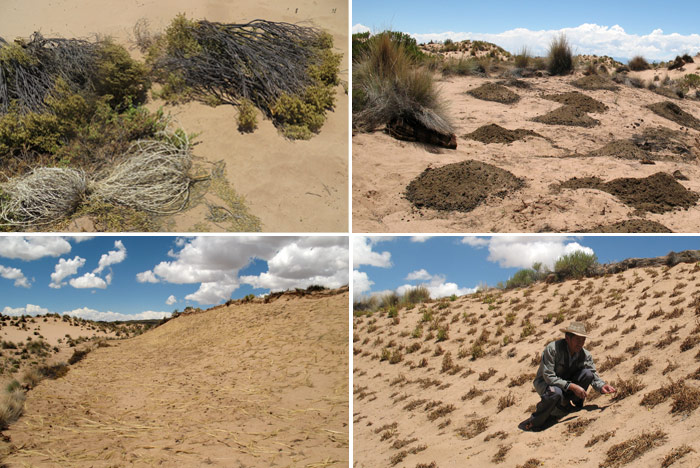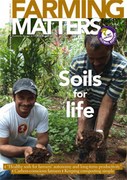The arid southern highlands of the Bolivian Andes are a harsh environment for even the most hardened farmers. The ‘quinoa boom’ and the move to mechanisation have led to shortened fallows and a drastic drop in soil organic matter. The dry sandy soils and the natural vegetation they support are increasingly degraded, but in the face of climate change and higher risks of drought, frosts and hailstorms, technical recommendations pay little attention to soil health. Farmers in the community of Lloco, however, have preserved their traditional practices that care for their fragile sandy soils and maintain resilience.

The balance between crops, animals and fallows ensures that there is enough manure.
The southern altiplano of Bolivia is characterised by the aridity and fragility of its soils. Only small areas of the hillsides are suitable for cropping, mainly potatoes, quinoa and barley, with the vast plains reserved for pastures that support llamas (Lama glama). Most farming families have access to both cropping and grazing land, and these are complementary components in local farming systems.
Mechanisation and the expansion of quinoa in the past two decades have undermined the sustainability of farming in the southern altiplano, with the introduction of tractors and rising quinoa prices having driven the changes. More land is going under the plough, upsetting the delicate balance between crops, pasture and fallows, destroying native vegetation, exposing soils to wind erosion, and damaging soil structure through compaction. Moreover, the expansion of land sown to quinoa has lead to less fallow and inexcreased demand for manure. But with relatively few animals, manure is becoming increasingly scarce, and since 2005 the price has increased fivefold.
Farmers in Lloco, a community in Orinoca County, have witnessed extensive soil degradation in neighbouring communities where tractors were introduced 15 years ago. But Lloco, like other communities in the county, are different because their sandy soils are scattered with sand dunes. This has not allowed the same increase in tractor use or land converted to quinoa, as in the communities, where there are no sand dunes. Their traditional farming system has come under far less pressure, but they are still worried about increasing soil degradation and especially because climate change is making farming more difficult. As a farmer in Lloco, Casiano García, says, “the rainy season in Lloco used to be between December and February but now it doesn’t start raining until the middle of January. This is a disaster for our potatoes and pastures.” As a consequence, the Lloco community is taking steps to preserve and adapt their traditional system to save their soil and their livelihoods.
Evolving systems

Their sandy soils are so fragile because they have such low natural levels of organic matter and are inherently low in nutrients. Moreover, agriculture in high altitude arid lands, between 3500 and 4000 metres above sea level, has a high risk of crop failure due to frost, drought and hail. Under these conditions, building and maintaining organic matter is key to maintaining soil structure, water storage, beneficial micro-organisms, and other physical and biochemical properties that support plant growth.
Such fragility is why, over millennia, farmers have learnt to cultivate only small areas but each with a high diversity of crops and use extended fallow periods, alongside pasture for raising livestock. This combination supports increased resilience to adverse weather, and with careful management of fallows, manure and mulch, the soil is relatively well protected.
A delicate balance
Maintaining the balance between crops, animals and fallows ensures that there is enough manure, an essential source of nutrients and organic matter. But the fallow must also be long enough to allow for adequate regeneration of native vegetation that protects soil from wind erosion and provides an important source of mulching material that further adds to building up soil organic matter.
Fifty years ago, land would be left fallow for at least 30 years but now, the trend is to reduce fallow length to two or three years and in extreme cases to just one year. Thirty years of fallow allows many different grasses, shrubs and legumes to regenerate. Important grasses such as sikuya (Stipa ichu) are used as mulching material, shrubs such as Paratrephia lepidophylla serve as living barriers, fuel and medicines and legumes such as salqa or q’ila-q’ila (Lupinus subacaulis, L. otto-buchieni, L. montanus) help to build soil fertility. The fallow lands also host wildlife such as high plateau armadillos (Chaetophractus Nationi), camelids and migratory birds.
A typical Lloco family grows mainly potato for home consumption and quinoa for both home consumption and cash income. They plant barley for animal feed, but in some years, barley is also eaten at home. Additional food and income comes from llama production. They used to raise sheep, introduced by the Spanish, but most families have abandoned this because sheep prefer improved grassland and need shepherding, whereas llamas can roam freely and tolerate lower quality pasture. And with youth migrating to the cities in search of jobs, there was no one left to tend the flocks.
Fallow, manure and mulch
After a ‘typical’ 20 to 30 year fallow, site preparation begins 3-12 months before the rainy season. The tallest shrubs are cut, leaving cut material on the ground as mulch and leaving the smaller shrubs and herbs alone. Manure is moved from grazing areas and piled where the shrubs were cut and covered with straw to reduce nutrient loss from strong winds that are common. Most families in Lloco collect manure from their own llama herds, otherwise they have to exchange or buy it from families with larger grazing areas.
In the middle of the short rains which usually last only two months (January and February), manure is spread evenly over the fields and hoed in, before the soil is covered with straw from a common unpalatable local grass called sikuya. The straw protects against erosion, against the sun, and reduces the soil from drying out during the cold and dry months. Timing of this activity is crucial, to maximise soil moisture and nutrients, in preparation for planting six months later. Crops are sown in advance of the rainy season, so that there is enough time to complete a growing cycle before the onset of winter. Potatoes are planted for two to three consecutive years before being followed by quinoa and barley. The typical rotation may be described as potato-potato-potato-barley, potato-potatoquinoa-barley or potato-quinoa, depending on the soil fertility and soil humidity.

Resilient food production
These traditional practices bring resilience to the Lloco food production system. While frosts and drought can always reduce yields, all production is never lost as happens in neighbouring communities, where the soil and native vegetation are degraded. For example, in 2003 most communities of Orinoca County lost their quinoa and potato crops to frost but the Lloco farmers managed to harvest potatoes. In addition, their healthy soil means a lower incidence of potato weevil, potato moth and late blight, the main potato pests and diseases in the Andes.
Ongoing challenges
The challenges of working these sandy soils are more than just technical. The traditional system of the Lloco community requires knowledge, skills, and is labour intensive. The knowledge needs to be shared between generations and the labour should not discourage youth from farming. For example, they are exploring small tools for pruning bushes and preparing straw mulch, equipment for transporting manure and, adapting motorcycles for farming, as ways to reduce labour requirements.
Another challenge faced in Lloco is the disconnect between their traditional knowledge and the advice given from local extensionists. Technical recommendations for their type of soil are either to stop farming altogether, or to stop cultivation and only raise livestock. However, farmers have developed their own resilient food production systems. They have proven that their system works, and technicians should listen to them, and begin a dialogue between traditional and scientific knowledge. More scientists are starting to work with farmers in Lloco, to find explanations for the fertility and moisture holding capacity of their sandy soils, and to learn about the reproductive cycles of the native grasses, shrubs and legumes.
The management of native vegetation and manure as sources of organic matter has been developed according to the needs of family farming in arid lands. Techniques developed by farmers of Lloco are appropriate for resilient, sustainable agriculture in such drylands, and have so far also been able to withstand market pressures such as the ‘quinoa boom’. And, seeing is believing – neighbouring communities are starting to listen to the Lloco farmers because they have seen their healthy crops, healthy soils and their products for sale on the market. With more climate change expected, such resilient systems need to be preserved more than ever before.
Alejandro Bonifacio Flores
Alejandro Bonifacio Flores is the Principal Investigator on Andean crops at the Fundación PROINPA (PROINPA Foundation) and is a part-time teacher at San Andres University in La Paz, Bolivia.
Email: a.bonifacio@proinpa.org

